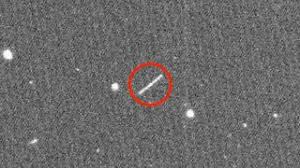Take that, asteroid 2020 QG!
Source: Space.com
The record-breaking asteroid 2020 QG won’t soon forget its run-in with Earth.
Early Sunday morning (Aug. 16), the car-sized 2020 QG zoomed just 1,830 miles (2,950 kilometers) above the Indian Ocean, making the closest known flyby by an asteroid that didn’t end up slamming into our planet.
Though 2020 QG survived the encounter, its path through space was altered significantly, scientists said.
“It’s really cool to see a small asteroid come by this close, because we can see the Earth’s gravity dramatically bend its trajectory,” Paul Chodas, director of the Center for Near-Earth Object Studies at NASA’s Jet Propulsion Laboratory in Southern California, said in a statement. “Our calculations show that this asteroid got turned by 45 degrees or so as it swung by our planet.”
Researchers didn’t learn of 2020 QG’s existence until the Zwicky Transient Facility, a survey telescope in Southern California funded by the U.S. National Science Foundation and NASA, captured an image of the asteroid zooming away from Earth, six hours after closest approach.
That image shows 2020 QG as a blurry streak — no surprise, considering that the space rock was rocketing along at about 29,000 mph (46,700 kph). As speedy as that is, it’s a little slower than average for a near-Earth asteroid, Chodas said.
There are many millions of near-Earth asteroids out there about the same size as 2020 QG, which is thought to be 10 to 20 feet (3 to 6 meters) wide. Such tiny space rocks are very hard to detect, but they pose no danger to life on Earth.
“If it [2020 QG] had actually been on an impact trajectory, it would likely have become a fireball as it broke up in Earth’s atmosphere, which happens several times a year,” NASA officials wrote in the same statement. (Fireballs are meteors that blaze more brightly than Venus in our skies.)
Big asteroids are a bit worrisome, however. For example, scientists think a 6-mile-wide (10 km) space rock did in the dinosaurs when it barreled into Earth 66 million years ago.
NASA has found and tracked more than 95% of the mountain-sized asteroids in Earth’s neighborhood, and none of them pose an impact risk in the foreseeable future. The space agency is currently working to compile a similarly comprehensive catalog of the near-Earth asteroids at least 460 feet (140 m) wide, which would do devastating damage on a regional scale if they hit.
Such work has practical applications beyond simply warning people about an impending impact. With enough notice — at least a few years, preferably — humanity could deflect an incoming asteroid, experts say.
Source: Space.com

































Leave a Comment
You must be logged in to post a comment.